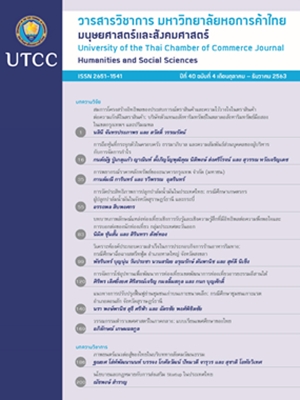Monographs on Thai Sexology in Central of Thailand: The Thai Sexology Textbooks
Main Article Content
Abstract
Knowledge of sexual activities or "monographs on Thai sexology" in the past of Thai society is often restricted in the area of storytelling and transmission. While the narrative about sex is hidden in the tradition and rituals, as well as the fine arts of the villagers and the royal family, it is assumed that there is a “monographs on Thai sexology” in Thai culture. It is similar to "Kama Sutra" in Indian culture or "Pillow Side Book" in Chinese culture. This article, therefore, aims to collect “monographs on Thai sexology” in the central region and analyze its knowledge as a "textbook". In this study, the researcher used data from literary texts found in the central region from the original manuscripts, including Khoi manuscripts, palm-leaf manuscripts and old notebooks based on eight titles. The results of the study showed that the presentation of knowledge was focused on four main parts, including posture, direction and auspicious, physiognomy and tonic. As "monographs on Thai sexology" is a "textbook", it is found that the teaching strategies in monographs on Thai sexology have various teaching strategies, including data classification, data explanation, use of advantage and technique tips. As for the technique for creating credibility for textbooks, it is found that there is reference to "the teacher who created the textbooks", citing supernatural powers and using specific codes for use by specific groups. The research results of would boost our understanding of Thai society through monographs on Thai sexology. The study of "Monographs on Thai Sexology" is not only a treasure trove of wisdom from the past, but it is also a knowledge of sexual science that is written extensively, showing the connection of various sciences, ways of thinking, expectations and efforts to create various activities to create "happiness" in interesting ways.
Article Details
ลิขสิทธิ์ของบทความ
ผลงานที่ได้รับการตีพิมพ์ถือเป็นลิขสิทธิ์ของมหาวิทยาลัยหอการค้าไทย ห้ามมิให้นำเนื้อหา ทัศนะ หรือข้อคิดเห็นใด ๆ ของผลงานไปทำซ้ำ ดัดแปลง หรือเผยแพร่ ไม่ว่าทั้งหมดหรือบางส่วนโดยไม่ได้รับอนุญาตเป็นลายลักษณ์อักษรจากมหาวิทยาลัยหอการค้าไทยก่อน
References
กาญจนา วิชญาปกรณ. (2554). มิติหญิงชายในวรรณกรรมสอนสตรี. วารสารมนุษยศาสตร์ มหาวิทยาลัยนเรศวร, 8(2), 1-20.
ชาลิน นุกูล. (2552). อิตถีภาวะในชายและบุรุษภาวะในหญิงในเพลงไทยยอดนิยม. (วิทยานิพนธ์ปริญญามหาบัณฑิต ไม่ได้ตีพิมพ์). จุฬาลงกรณ์มหาวิทยาลัย, กรุงเทพฯ.
ธนากิต. (มปป.). ตำราพรหมชาติ ฉบับสมบูรณ์. กรุงเทพฯ: ปิรามิด.
ผ่า “สมุดใต้หมอน” ในราชสำนักจีนจดเคล็ด-ท่วงท่าแห่งรัก สะท้อนคติเรื่องเซ็กซ์ยุคโบราณ. (2562, มิถุนายน). ศิลปวัฒนธรรม. สืบค้นจาก https://www.silpa-mag.com/article/article_34688
ระพินทร์. (2509). มหาตำรับรักของฮินดู: โลกียสูตร. กรุงเทพฯ: แพร่พิทยา.
วัดพระเชตุพน. (2559). สมุดภาพโคลงฤๅษีดัดตน [จัดพิมพ์เฉลิมพระเกียรติพระบาทสมเด็จพระเจ้าอยู่หัว เนื่องในโอกาสมหามงคลทรงครองราชย์ 70 ปี มหามงคลเฉลิมพระชนมพรรษา 89 พรรษา เฉลิมพระเกียรติสมเด็จพระนางเจ้าสิริกิติ์ พระบรมราชินีนาถ เนื่องในโอกาสมหามงคลเฉลิมพระชนมพรรษา 84 พรรษา และเฉลิมพระเกียรติสมเด็จพระเทพรัตนราชสุดาฯ สยามบรมราชกุมารี เนื่องในโอกาสมหามงคลเฉลิมพระชนมพรรษา 61 พรรษา]. กรุงเทพฯ: อมรินทร์พริ้นติ้งแอนด์พับลิชชิ่ง.
สนิท สมัครกาล. (2519). บทบาทของครอบครัวที่มีต่อบุคลิกภาพของคนไทย. ใน สมบัติ จันทรวงศ์ และรังสรรค์ ธนะพรพันธุ์ (บรรณาธิการ), รักเมืองไทย (เล่ม 1) (น. 31-32). กรุงเทพฯ: สมาคมสังคมศาสตร์แห่งประเทศไทย, โครงการตำราสังคมศาสตร์และมนุษยศาสตร์.
สันติชัย แย้มใหม่. (2556). มายาคติทางเพศสภาพผ่านสัญญะในพิธีโนราโรงครู (วิทยานิพนธ์ปริญญามหาบัณฑิต ไม่ได้ตีพิมพ์). มหาวิทยาลัยสงขลานครินทร์, สงขลา.
สุกัญญา สุจฉายา. (2527). เพลงปฏิพากย์: การศึกษาเชิงวรรณคดีวิเคราะห์. (วิทยานิพนธ์ปริญญามหาบัณฑิต ไม่ได้ตีพิมพ์). จุฬาลงกรณ์มหาวิทยาลัย, กรุงเทพฯ,
สุระ อินตามูล. (2555). พิธีกรรมทรงผีเจ้านาย: พื้นที่เปิดทางเพศภาวะในสังคมล้านนา (รายงานผลการวิจัย). สืบค้นจาก ฐานข้อมูลงานศึกษาวิจัยศูนย์มานุษยวิทยาสิรินธร.
หรีด เรืองฤทธิ์. (มปป.). ตำราพรหมชาติ ฉบับสมบูรณ์ ตำรานรลักษณ์ฉบับหลวงในรัชกาลที่ 1. กรุงเทพฯ: เลี่ยงเซียงจงเจริญ,
อรวรรณ ชมดง, และอรทัย เพียยุระ. (2557). เพศวิถีและสังคมไทยในวรรณกรรมเพลงลูกทุ่ง. วารสารบัณฑิตศึกษา มนุษยศาสตร์ สังคมศาสตร์, 3(2), 77-98.


